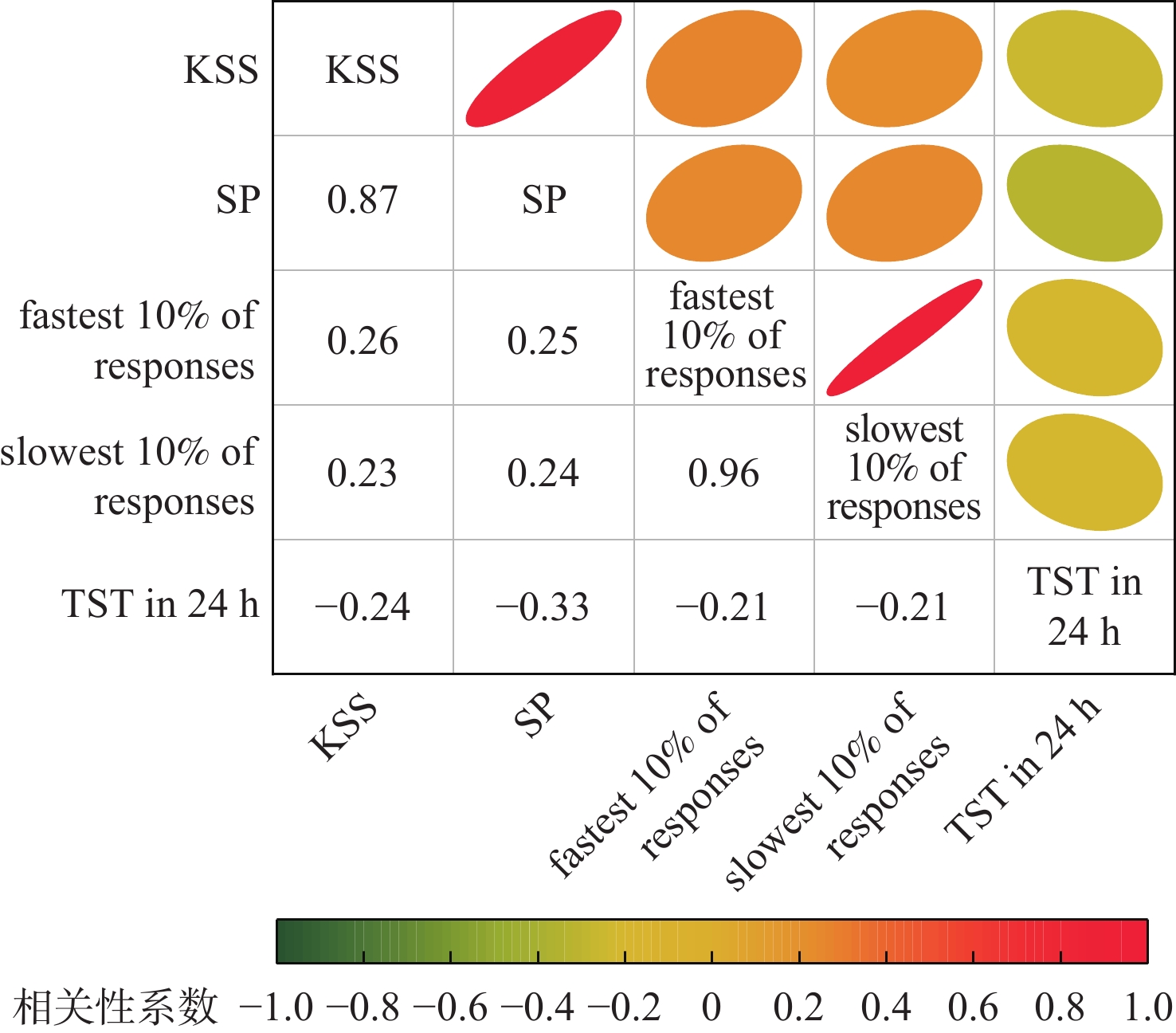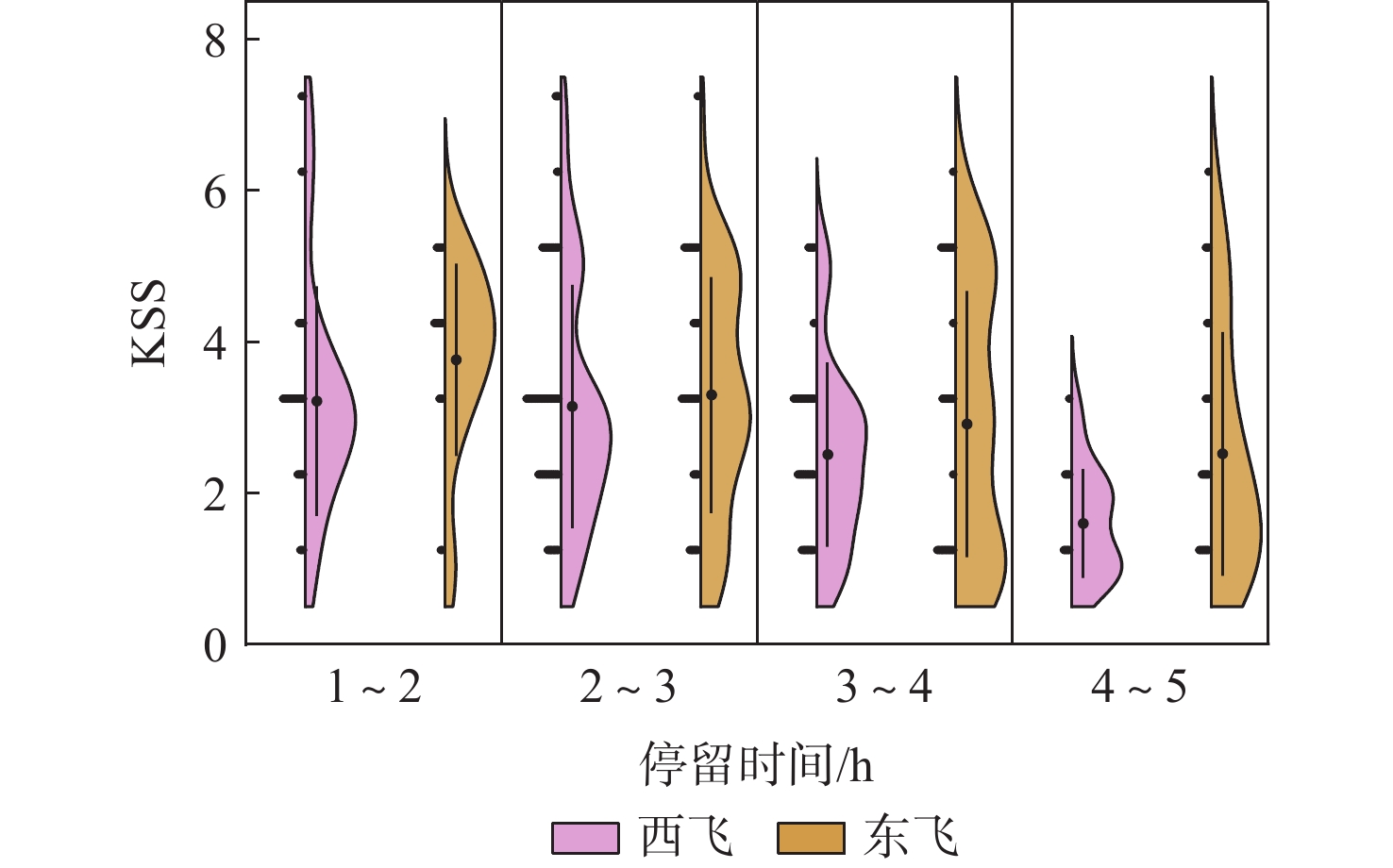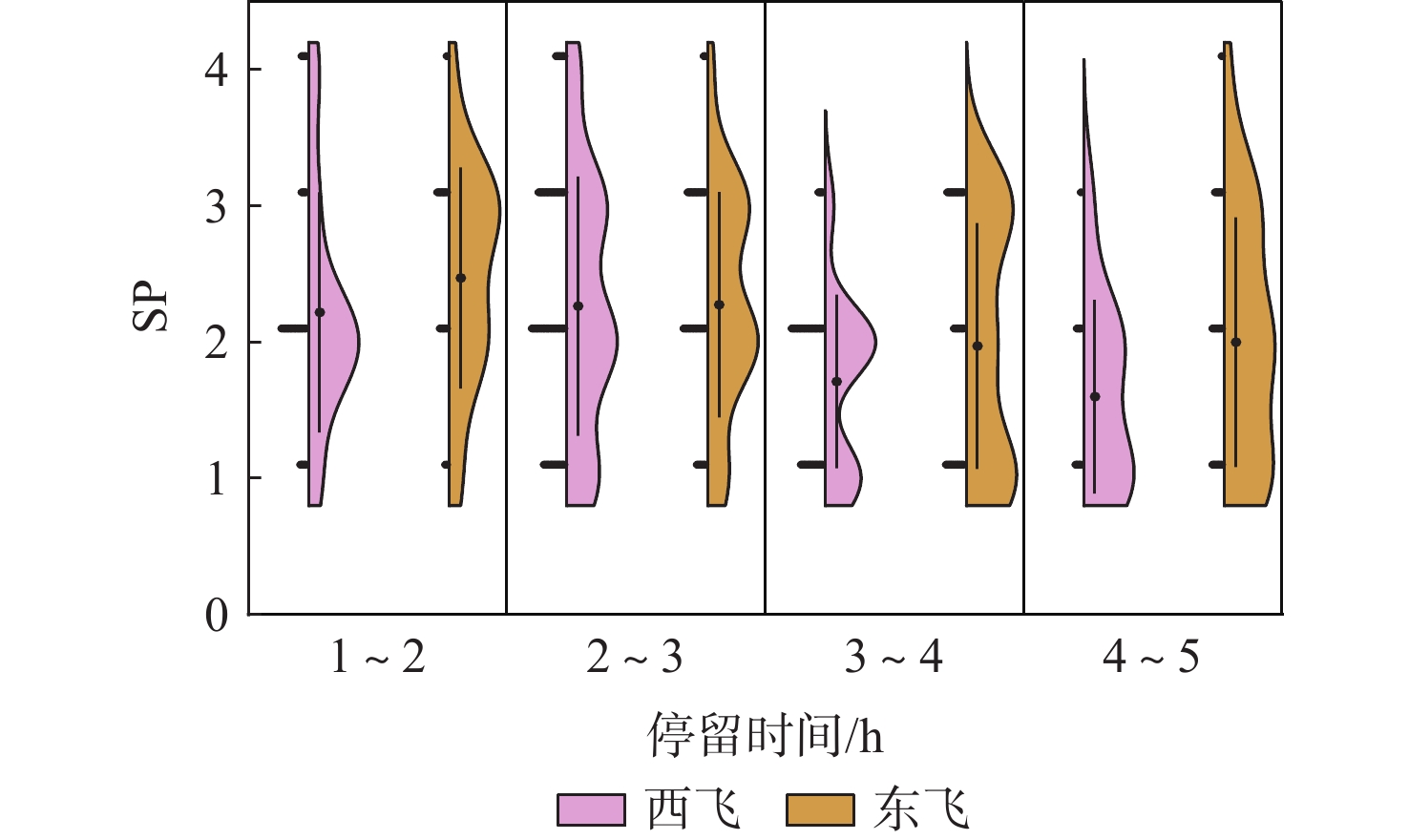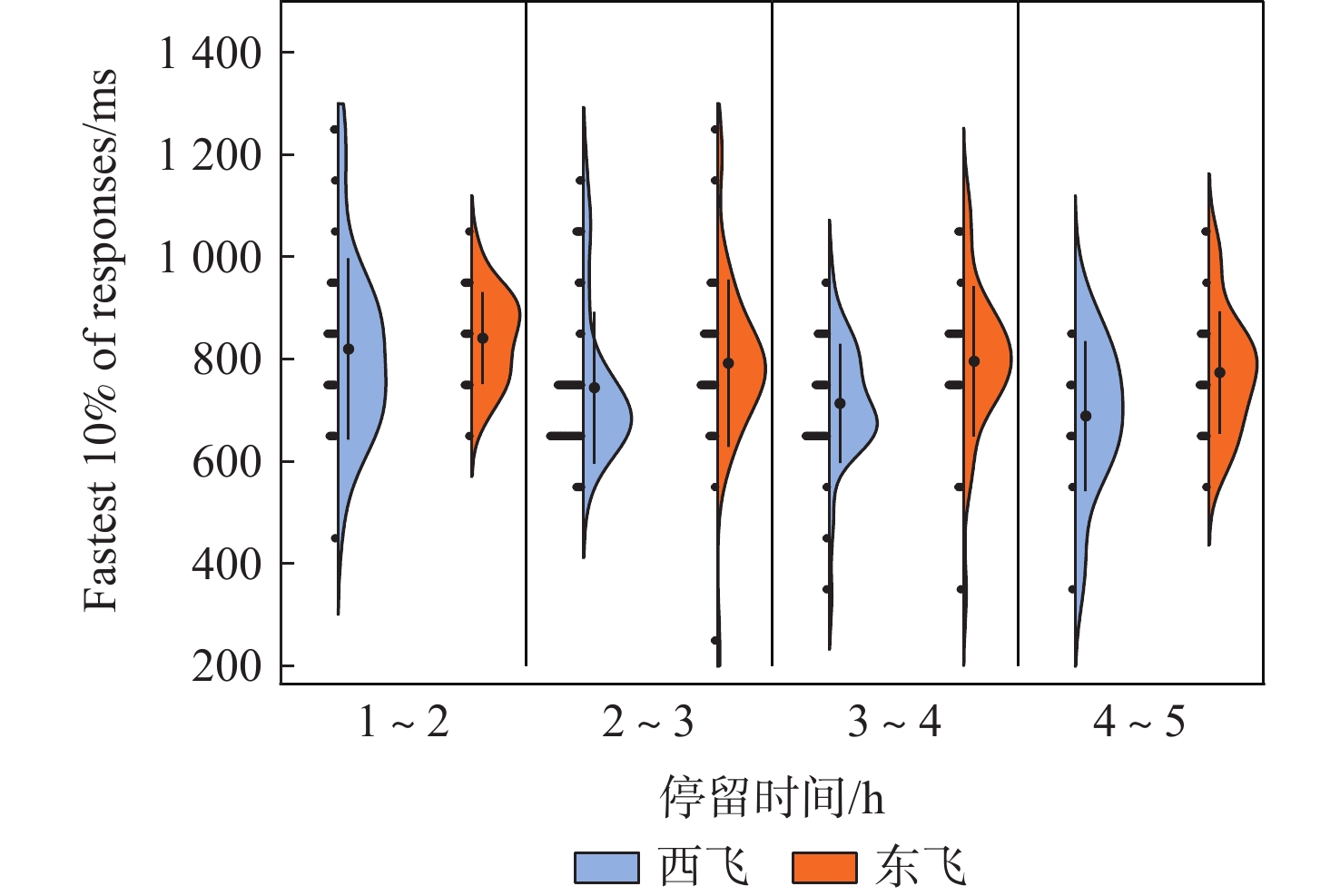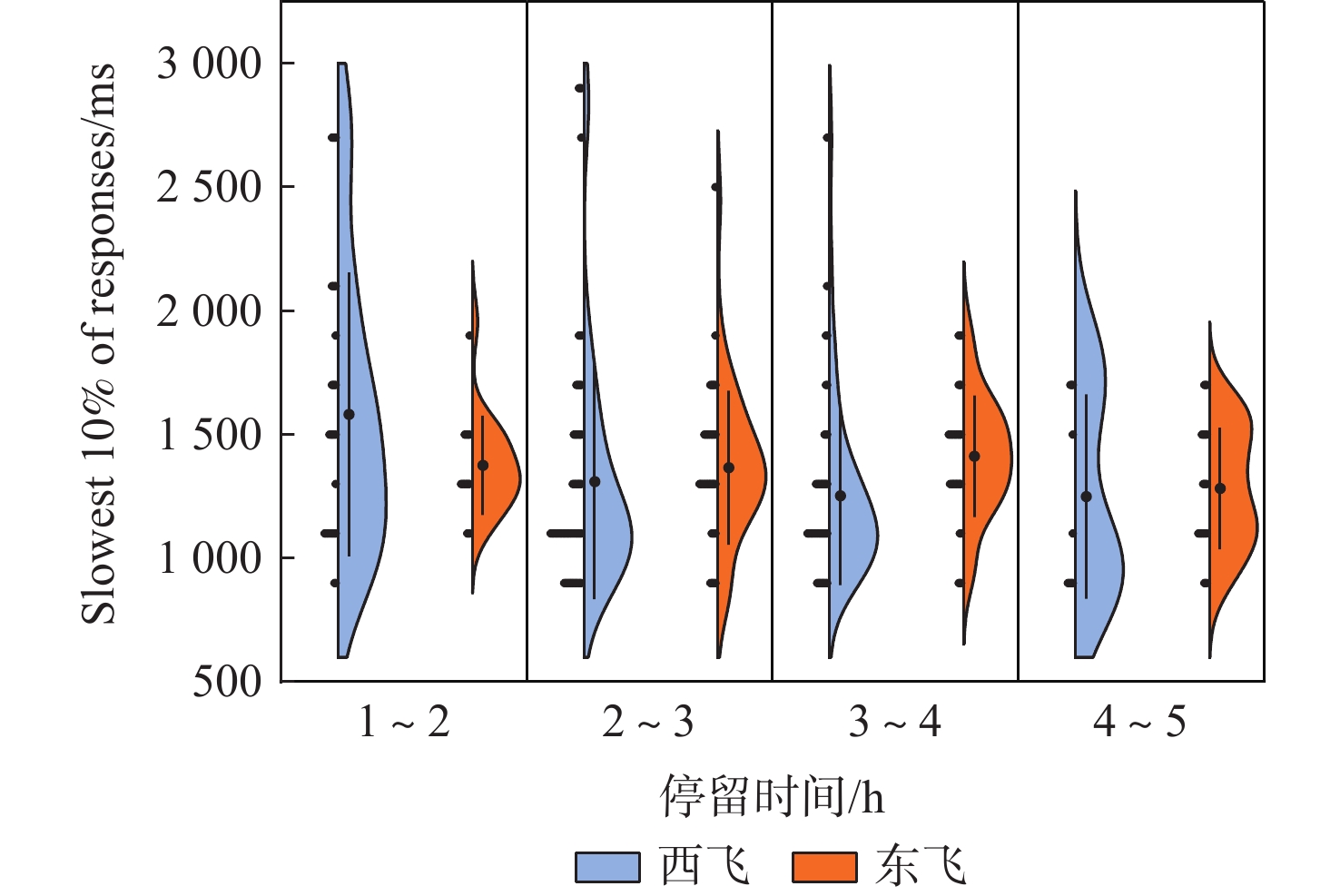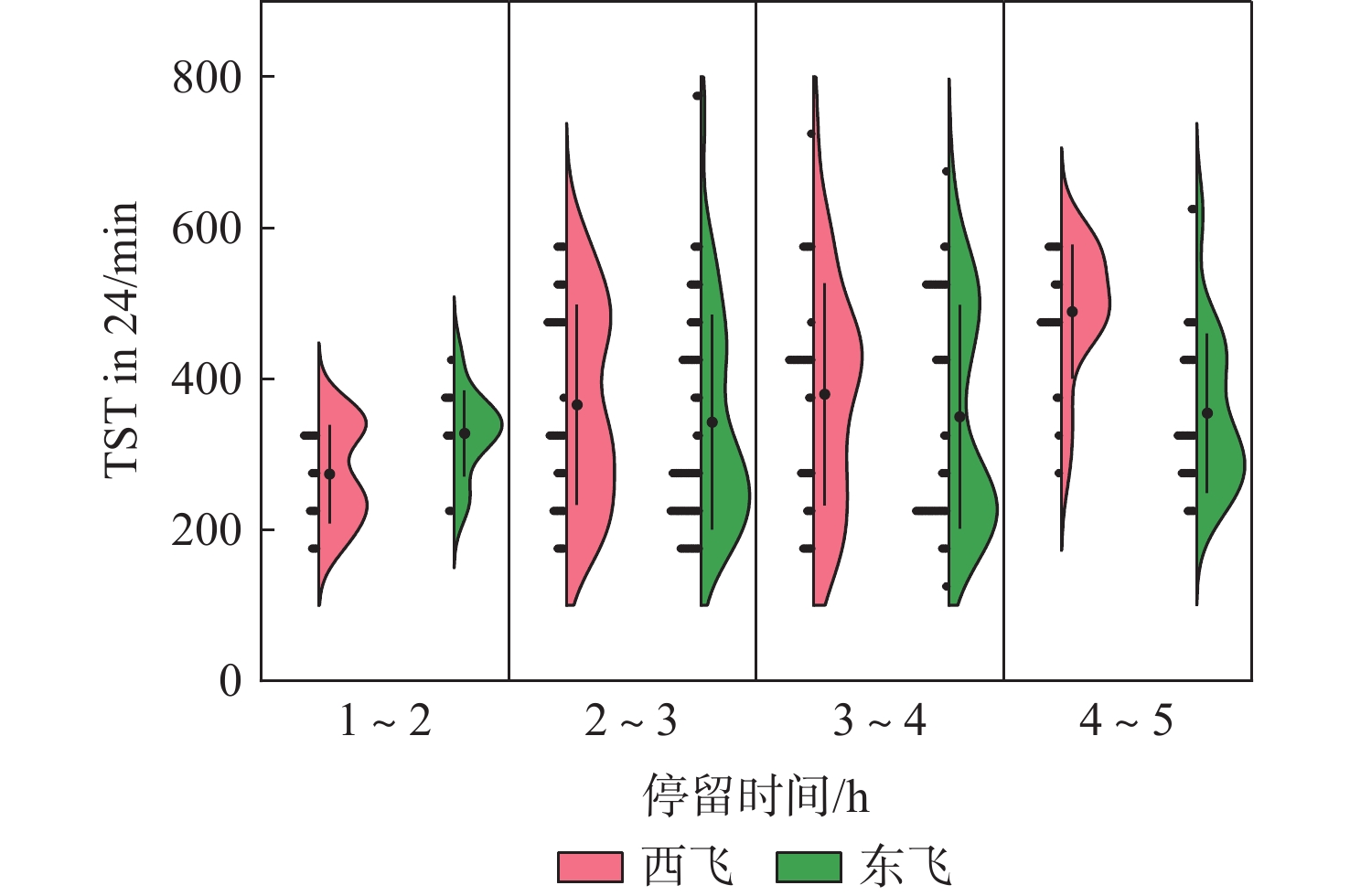-
摘要:
基于疲劳风险管理系统的应用正在全球航空业中迅速展开,在防疫豁免期间,收集实际运行模式下64名国际豁免航班飞行员在不同中转停留时间下的主观自评、客观测试和睡眠信息等数据。运用SPSS27.0统计学软件,利用相关性分析和重复测量方差分析的方法,深入地分析不同中转停留时间及飞行方向对国际豁免航班飞行员警觉性的影响,并用Origin软件绘制相关性系数图和半小提琴图。结果表明:停留时间为1~2 h时,国际豁免航班飞行员的警觉性水平明显较低,向东飞行的飞行员要比向西飞行的警觉性水平更低。这些发现有助于航空公司在防疫豁免运行环境中监测和分析国际豁免航班飞行员的警觉性,为加强中转航班过站保障措施提供借鉴。
Abstract:Survey based on the fatigue risk management system has been conducted at an unprecedented speed in the global aviation industry. During the quarantine exemption period, data such as subjective ratings, objective tests, and sleeping information were collected from 64 pilots of international flights exempted from quarantine under different layover lengths in actual operation mode. The SPSS27.0 software, correlation analysis, and analysis of variance of repeated measures were used to deeply analyze the influence of different layover lengths and flight directions on the alertness of pilots of international flights exempted from quarantine. Correlation coefficient diagrams and half violin plots were painted by Origin software. The results show that when the layover length is 1–2 h, the alertness level of pilots of international flights exempted from quarantine is significantly lower. The alertness level of pilots of eastward flights is lower than that of westward flights. These findings can help airlines monitor and analyze the alertness of pilots of international flights exempted from quarantine during the quarantine exemption period and provide references for strengthening the protection measures for layover flights.
-
表 1 航班信息汇总
Table 1. Summary of flight informations
航班 停留时间/h 飞行员人次 飞行方向 飞行时间/h 值勤时间/h 跨越时区/h 洛杉矶−北京 1~2 6 西飞 12.81 ± 1.77 13.53 ± 1.61 −16 洛杉矶−北京 2~3 12 西飞 13.60 ± 1.55 13.82 ± 1.59 −16 洛杉矶−北京 3~4 9 西飞 13.17 ± 1.90 13.81 ± 2.19 −16 洛杉矶−北京 4~5 5 西飞 13.04 ± 1.57 14.32 ± 2.27 −16 阿姆斯特丹−北京 1~2 6 东飞 11.54 ± 0.61 11.62 ± 0.68 +7 阿姆斯特丹−北京 2~3 9 东飞 11.46 ± 0.65 12.08 ± 0.69 +7 阿姆斯特丹−北京 3~4 10 东飞 11.40 ± 0.43 11.94 ± 0.53 +7 阿姆斯特丹−北京 4~5 7 东飞 12.15 ± 0.16 13.01 ± 0.35 +7 表 2 KSS与SP相关性分析
Table 2. Correlation analysis of KSS and SP
指标 相关系数R 显著性p KSS SP KSS SP KSS 1.000 0.874 0.000 0.000 SP 0.874 1.000 0.000 0.000 表 3 主观自评与客观测试指标间的相关性分析
Table 3. Correlation analysis of subjective rating and objective test indicators
指标类型 相关系数R 显著性p KSS SP KSS SP fastest 10% of responses 0.262 0.253 0.013 0.016 slowest 10% of responses 0.227 0.240 0.032 0.023 TST in 24 h −0.240 −0.326 0.023 0.002 表 4 双因素方差分析表
Table 4. Two-factor analysis of variance
方差来源 平方和 自由度 均方 方差 效应量 因素A SA r−1 ¯SA=SAr−1 FA=¯SASE η2A=SAST−SB−SA×B 因素B SB s−1 ¯SB=SBs−1 FB=¯SBSE η2B=SBST−SA−SA×B 交互作用A×B SA×B (r−1)(s−1) ¯SA×B=SA×B(r−1)(s−1) FA×B=¯SA×BSE η2A×B=SA×BST−SA−SB 误差 SE rs(t−1) ¯SE=SErs(t−1) 总和 ST rst−1 表 5 方差分析结果
Table 5. Results from analysis of variance
安全性能指标 F p η2 飞行方向 停留时间 飞行方向与
停留时间飞行方向 停留时间 飞行方向与
停留时间飞行方向 停留时间 飞行方向与
停留时间KSS 19.656 7.221 0.872 0.000 0.000 0.403 0.169 0.126 0.012 SP 2.640 5.794 0.714 0.015 0.001 0.545 0.067 0.092 0.008 fastest 10% of responses 11.302 2.751 0.522 0.001 0.043 0.667 0.141 0.063 0.006 slowest 10% of responses 7.602 6.798 0.487 0.006 0.003 0.692 0.118 0.109 0.005 TST in 24 h 6.224 2.524 0.679 0.013 0.045 0.613 0.105 0.062 0.007 -
[1] ROACH G D, PETRILLI R M A, DAWSON D, et al. Impact of layover length on sleep, subjective fatigue levels, and sustained attention of long-haul airline pilots[J]. Chronobiology International, 2012, 29(5): 580-586. doi: 10.3109/07420528.2012.675222 [2] 中国民用航空局. 疫情期间豁免机组成员值勤期、飞行时间限制的实施办法[EB/OL]. (2020-12-02) [2022-09-14].Civil Aviation Administration of China. Implementation measures for exempting crew members from duty period and flight time limitations during the epidemic period.[EB/OL]. (2020-12-02) [2022-09-14]. [3] REIS C, MESTRE C, CANHÃO H. Prevalence of fatigue in a group of airline pilots[J]. Aviation, Space, and Environmental Medicine, 2013, 84(8): 828-833. doi: 10.3357/ASEM.3548.2013 [4] VAN DRONGELEN A, BOOT C R L, HLOBIL H, et al. Risk factors for fatigue among airline pilots[J]. International Archives of Occupational and Environmental Health, 2017, 90(1): 39-47. doi: 10.1007/s00420-016-1170-2 [5] 于洮, 刘德宝, 孙梦婷, 等. 陆军航空兵飞行员睡眠状况与疲劳程度的相关性分析[J]. 华南国防医学杂志, 2018, 32(9): 639-641.YU T, LIU D B, SUN M T, et al. Correlation analysis between sleep condition and fatigue degree of army aviation pilots[J]. Military Medical Journal of South China, 2018, 32(9): 639-641(in Chinese). [6] 曾绍洁, 李红霞, 刘微卫, 等. 全封闭式管理对飞行员睡眠质量及疲劳状态的影响[J]. 空军医学杂志, 2022, 38(2): 102-106.ZENG S J, LI H X, LIU W W, et al. Effects of fully enclosed restrictive management on sleep quality and fatigue of pilots[J]. Medical Journal of Air Force, 2022, 38(2): 102-106 (in Chinese). [7] 刘艳, 程宝权, 于鑫, 等. 直升机飞行员脑力负荷、睡眠和疲劳的典型相关分析[J]. 陆军军医大学学报, 2022, 44(11): 1087-1093.LIU Y, CHENG B Q, YU X, et al. Mental workload, sleep and fatigue in helicopter pilots: A canonical correlation analysis[J]. Journal of Army Medical University, 2022, 44(11): 1087-1093 (in Chinese). [8] 汪磊, 郑竹寒, 张之洋. 基于警觉性的疲劳程度自测系统研究[J]. 航天医学与医学工程, 2021, 34(5): 361-366.WANG L, ZHENG Z H, ZHANG Z Y. Research on self-test system of fatigue degree based on vigilance[J]. Space Medicine & Medical Engineering, 2021, 34(5): 361-366 (in Chinese). [9] PAN T, WANG H B, SI H Q, et al. Identification of pilots' fatigue status based on electrocardiogram signals[J]. Sensors, 2021, 21(9): 3003. doi: 10.3390/s21093003 [10] HONN K A, SATTERFIELD B C, MCCAULEY P, et al. Fatiguing effect of multiple take-offs and landings in regional airline operations[J]. Accident; Analysis and Prevention, 2016, 86: 199-208. doi: 10.1016/j.aap.2015.10.005 [11] GASPERETTI C E, DONG L, HARVEY A G. The effect of the transdiagnostic sleep and circadian intervention (TranS-C) on actigraphic estimates of sleep and rest-activity rhythms in adolescents with an evening circadian preference[J]. Sleep Health, 2022, 8(2): 191-194. doi: 10.1016/j.sleh.2021.10.007 [12] International Civil Aviation Organization. Fatigue risk man a gement systems manual for regulators[EB/OL]. (2011-07-24) [2022-09-16]. [13] GOFFENG E M, WAGSTAFF A, NORDBY K C, et al. Risk of fatigue among airline crew during 4 consecutive days of flight duty[J]. Aerospace Medicine and Human Performance, 2019, 90(5): 466-474. doi: 10.3357/AMHP.5236.2019 [14] 张英, 陈晨, 刘振华, 等. 精神运动警觉性任务在不同知觉负荷下的疲劳状态监测[J]. 心理学探新, 2018, 38(4): 377-384.ZHANG Y, CHEN C, LIU Z H, et al. Psychomotor vigilance monitors different fatigue states[J]. Psychological Exploration, 2018, 38(4): 377-384 (in Chinese). [15] GANDER P H, MULRINE H M, VAN DEN BERG M J, et al. Effects of sleep/wake history and circadian phase on proposed pilot fatigue safety performance indicators[J]. Journal of Sleep Research, 2015, 24(1): 110-119. doi: 10.1111/jsr.12197 [16] 温忠麟, 范息涛, 叶宝娟, 等. 从效应量应有的性质看中介效应量的合理性[J]. 心理学报, 2016, 48(4): 435-443. doi: 10.3724/SP.J.1041.2016.00435WEN Z L, FAN X T, YE B J, et al. Characteristics of an effect size and appropriateness of mediation effect size measures revisited[J]. Acta Psychologica Sinica, 2016, 48(4): 435-443 (in Chinese). doi: 10.3724/SP.J.1041.2016.00435 [17] 沈光辉, 范涌峰, 陈婷. 教育研究中的P值使用: 问题及对策: 兼谈效应量的使用[J]. 数学教育学报, 2019, 28(4): 92-98.SHEN G H, FAN Y F, CHEN T. Using P value in educational research: problems and countermeasures—concurrently discussing about the use of effect quantity[J]. Journal of Mathematics Education, 2019, 28(4): 92-98 (in Chinese). [18] KOSMADOPOULOS A, SARGENT C, ZHOU X, et al. The efficacy of objective and subjective predictors of driving performance during sleep restriction and circadian misalignment[J]. Accident; Analysis and Prevention, 2017, 99: 445-451. [19] GANDER P H, SIGNAL T L, VAN DEN BERG M J, et al. In-flight sleep, pilot fatigue and psychomotor vigilance task performance on ultra-long range versus long range flights[J]. Journal of Sleep Research, 2013, 22(6): 697-706. doi: 10.1111/jsr.12071 [20] SIGNAL T L, MULRINE H M, VAN DEN BERG M J, et al. Mitigating and monitoring flight crew fatigue on a westward ultra-long-range flight[J]. Aviation, Space, and Environmental Medicine, 2014, 85(12): 1199-1208. doi: 10.3357/ASEM.4034.2014 -







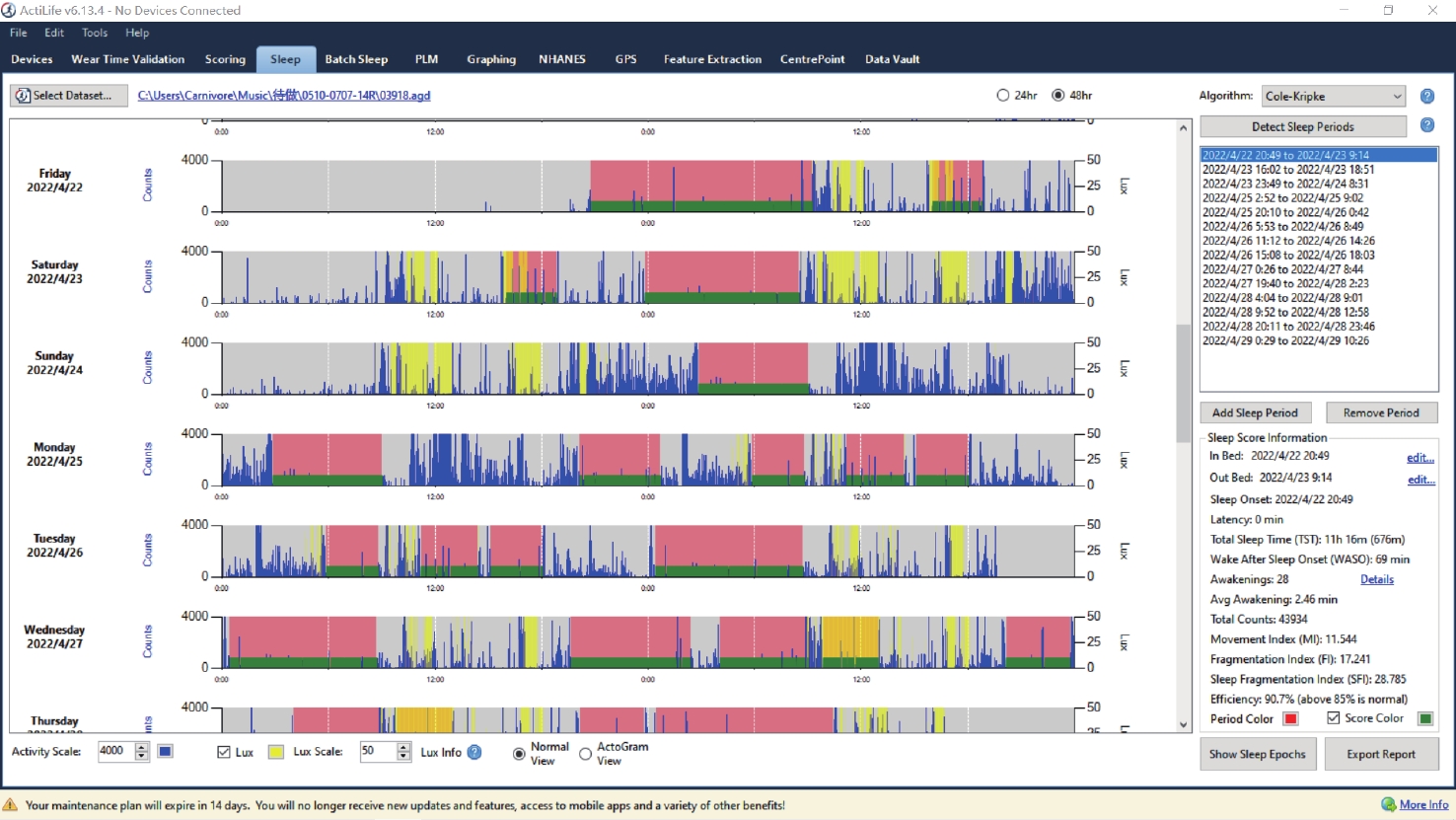
 下载:
下载:
